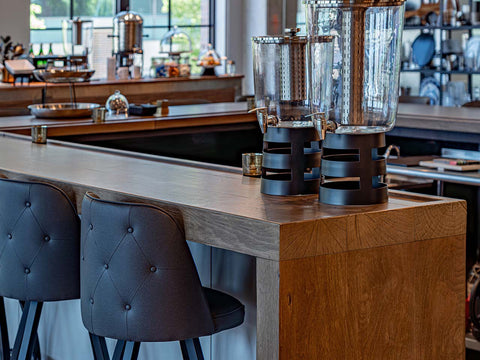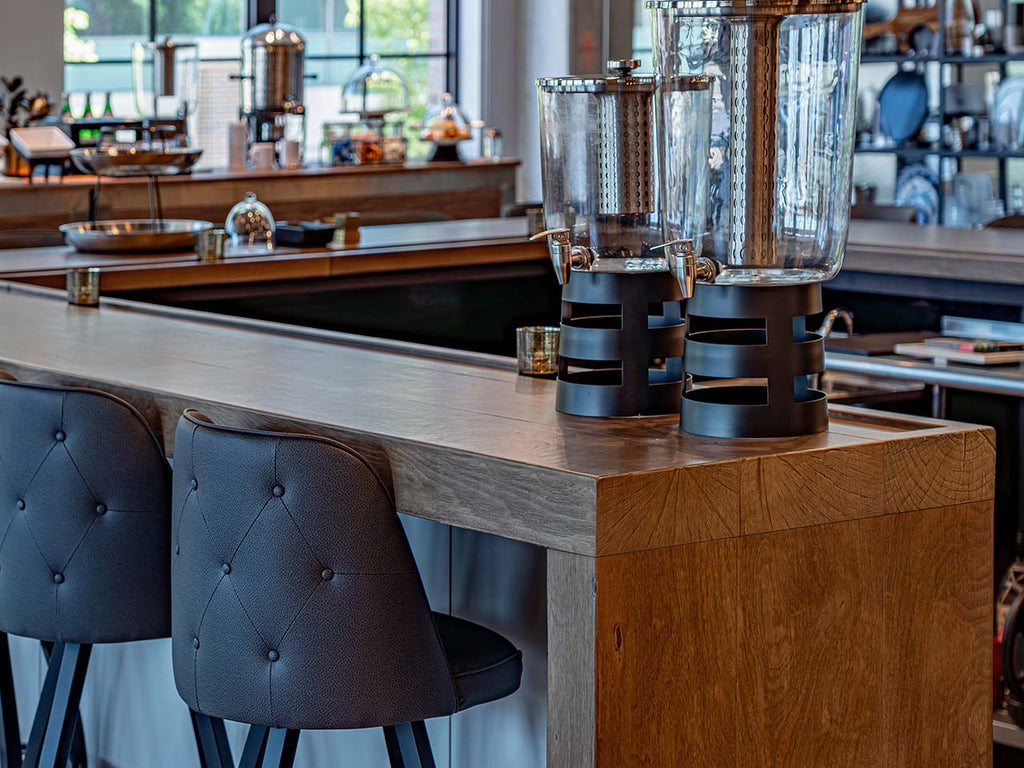
Concrete Vs Wood Kitchen Countertops

When it comes to material selection for high-traffic kitchens in hospitality, retail, or mixed-use environments, designers and builders need solutions that balance aesthetics, performance, and long-term value. Two popular choices—concrete and wood—offer dramatically different performance profiles. Here's how butcher block vs concrete countertops compare.
Durability & Lifecycle Value
Concrete countertops, particularly when fabricated with GFRC (glass fiber reinforced concrete), deliver exceptional durability. With a projected lifespan of up to 50 years, concrete resists heat, staining, and wear under heavy use. This makes it ideal for environments like commercial kitchens, hotel suites, and bar areas where daily wear is unavoidable.
Wood, while visually warm and natural, has a significantly shorter service life. Prone to moisture damage, warping, and staining, wood countertops generally require refinishing every 8–10 years, particularly in humid or wet-use zones. For high-traffic commercial applications, that adds cost, labor, and downtime over time.

Performance in Wet & Heated Zones
Commercial-grade concrete countertops, such as Trueform's Woodform® Concrete, are sealed with food-safe, UV-stable coatings that resist water and allow for installation near sinks, dishwashers, and steam-producing equipment. While trivets are still recommended for extended direct heat, concrete tolerates typical kitchen heat exposure far better than wood.
Wood expands, contracts, and degrades when exposed to prolonged moisture or direct heat. This makes it less ideal for service kitchens, back-of-house applications, or spa and wellness centers where water exposure is routine.
Customization & Spec Control
Concrete's versatility in casting and color matching gives specifiers unmatched control. Trueform offers complete freedom with edge profiles, integrated sinks, embedded details, and color-matching to Pantone or paint swatches. Seamless spans and waterfall edges are routine.
Wood, while rich in character, offers limited customization. Species, grain direction, and cut size impose design constraints. Large-scale installations often require joins, which may compromise both aesthetics and longevity.

Fabrication & Installation Workflow
Trueform Concrete's precast approach means each piece is engineered off-site in a controlled environment, minimizing field fabrication. Standard lead times accommodate most commercial build schedules, and technical submittals including CADs and cut sheets are available for architectural review.
Wood countertops may require on-site modification, are susceptible to ambient humidity during install, and are less predictable dimensionally, especially across long spans.
Sustainability & Compliance
Concrete countertops can contribute to LEED credits, especially when locally sourced and made-to-order. Trueform’s products are crafted in New Jersey, which supports projects prioritizing domestic production and reduced transportation impact.
Wood, depending on species and source, may be sustainably harvested, but also may not meet fire-resistance or sanitation codes for certain applications.

Best-Fit Commercial Applications
Concrete excels in:
- Restaurant and hospitality bars
- Multifamily kitchens and vanities
- Boutique hotel bathrooms
- ADA-compliant wall-mounted vanities
- Wellness and spa environments
Wood works best in:
- Office coffee bars
- Low-traffic residential spaces
- Retail point-of-sale counters (with routine upkeep)
A Material Built for the Trade
For commercial specifiers balancing durability, design, and lifetime ROI, Woodform® Concrete outperforms wood in nearly every key metric. It offers artisan craftsmanship with industrial-grade performance—all with the aesthetic warmth designers love.

Ready to Specify Woodform® Concrete?
- Go to Architect & Designer Resources
- Book a Design Consultation
- View Commercial Vanity & Woodform Concrete Portfolio
Crafted in the USA. Engineered for commercial excellence.